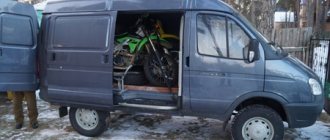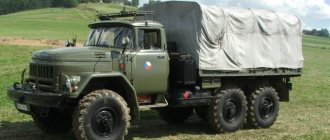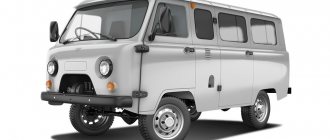Back in 1964, the Gorky Automobile Plant first produced the legendary GAZ-66 truck or, as it is popularly called, “Shishiga”. During the production of the model, which is more than 30 years, about 950 thousand copies of the car were produced from the assembly line. GAZ-66 quickly gained popular recognition and widespread use. "Shishiga" was actively involved in the needs of the Soviet army and in agricultural activities. Even today you can find cars in large numbers on the roads of post-Soviet countries.
The demand and popularity of the “shishiga” is justified by the fact that this vehicle is characterized by high cross-country ability and increased reliability. The design of a two-axle truck is simple and outstanding - this is the main thing that was required from cars, both in the last century and today. The truck was equipped with various variations of power units, but the ZMZ 513 and ZMZ 6606 engines proved to be the best. The truck weighs about 3.5 tons, so conversations about what fuel consumption per 100 km for the GAZ-66 are the most relevant among car owners and among those who want to own this car.
Characteristics of GAZ-66
The GAZ-66 frame car with a cabin located above the engine was created for the armed forces of the USSR. The first samples were ready in 1957, but mass production began after the start of assembly of the ZMZ V-shaped 8-cylinder engine.
The design of the army vehicle was partially unified with the civilian truck of the GAZ-53 model, which reduced production costs.
Manufacturing history
In the post-war years, the Gorky Automobile Plant mastered the production of the GAZ-51 car and the unified army version of the GAZ-63. But after 10 years, the cars became outdated and no longer suited the main customer. Therefore, the plant developed a project for a new machine with improved technical characteristics.
Serial production of the GAZ-66 army truck with a 125-horsepower gasoline engine began in 1964, and 5 years later the product was awarded a quality mark. The car was also supplied to civilian customers, and was also exported to socialist countries.
During the production process, several modernizations were carried out aimed at reducing fuel consumption and increasing operational safety (for example, lighting technology was changed and braking characteristics were improved).
By the mid-90s. The plant was experiencing difficulties in selling the outdated truck, so the hooded model 3308 Sadko went into production, unified in the cab with the civilian modification 3307 and retaining the chassis and transmission from its predecessor.
... about popular models
Modifications of Sadko lasted on the assembly line until the beginning of 2020.
new GAZ-66
Internal structure of GAZ-66
The power unit is located in the front of the frame. Torque is converted by a 4-speed gearbox and a 2-speed transfer gearbox, which allows you to disable the front wheel drive.
The axles are mounted on leaf springs, and hydraulic shock absorbers are used at the front.
The standard equipment of the vehicle included hydraulic power steering (civilian GAZ-53s were not equipped with a similar unit). To transport cargo or people, a platform with a tarpaulin awning was used, the carrying capacity was 2 tons (with a dead weight of 3.47 tons).
In the GAZ-66 cabin, made of steel sheet (the landing model had a canvas roof), there are seats for the driver and attendant, separated by the engine hood. To service the power unit, it is necessary to tilt the cab forward. Some operations can be performed from the interior by removing the metal cover.
... about the model parameters
The transmission control levers are located in a narrow niche between the rear wall of the hood and the cabin bulkhead, making shifting difficult for an inexperienced driver.
Modifications of GAZ-66
Over the years of production, several dozen modifications of the truck came out of the GAZ plant:
an early basic version of the GAZ-66, not equipped with a tire pressure regulation system;- an early version of the 66A, equipped with a winch, but without tire pressure adjustment;
- landing model GAZ-66B, distinguished by a folding cab roof and a folding steering wheel and windshield frame;
- modification of the GAZ-66F, equipped with a winch and shielded electrical circuits, but without tire pressure adjustment;
- serial 66-01, equipped with pressure regulation (without winch);
- version GAZ-66-02, which differed from 66-01 in the installation of a winch;
- modification 66-11, which entered the series in 1985 and was a modernized version of 66-01;
- model 66-16, which had a payload capacity increased by 300 kg and was produced in 1991-92;
- versions 66-21 and 66-22, distinguished by the use of tires with a road tread pattern (twin tires were installed on the rear axle);
- chassis 66-31, proposed for the installation of dump truck superstructures (the transmission had a power take-off to drive the hydraulic system pump).
All of the above modifications existed in a tropical version, designed for operation in hot and humid climates (offered for export).
The plant shipped chassis to customers, on which special superstructures were then installed. For example, the armed forces of the USSR received sanitary modifications and disinfection vehicles, as well as platforms for transporting pontoon parks.
Civil services mounted vans on chassis to deliver food or medical personnel to remote areas of the country. A certain number of chassis with all-wheel drive were built in a bus modification and were used by the PAZ plant in the assembly of PAZ-3201 and 3206 vehicles.
The GAZ-66 models listed above used variants of the ZMZ-513 gasoline carburetor engine, built on the basis of a V-shaped 8-cylinder block. The power unit developed power up to 125 hp. pp., aluminum alloy was used for the manufacture of the block and heads. The compression ratio did not exceed 7.6 units; gasoline with an octane number of 76 units using the motor method was used as fuel.
... about the model parameters
After the start of deliveries of cars to civilian buyers, diesel modifications with reduced fuel consumption appeared.
Serial versions of the GAZ-66 with a diesel engine:
- In 1995, the assembly of trucks and chassis 66-40 began, equipped with an in-line 4-cylinder GAZ-5441 engine with a forced air cooling system. The engine was equipped with a turbine, which increased the power to 116 hp. The vehicles were distinguished by an increased load capacity of up to 2.3 tons; a tire inflation system and a winch were installed upon request.
- Since 1993, chassis and flatbed trucks with an 85-horsepower naturally aspirated modification of the GAZ-544 diesel engine and a remote tire pressure adjustment system (a winch was supplied as an option) were assembled in small batches. The assembly of cars stopped in 1995 due to the start of production of a modification with a turbodiesel.
Technical characteristics of GAZ-66
Technical parameters of a car with a gasoline engine and a winch:
- length - 5806 mm;
- width - 2322 mm;
- height with awning - 2520 mm;
- center distance - 3300 mm;
- ground clearance (under axle housings) - 315 mm;
- maximum weight with cargo - 5940 kg;
- highway speed - up to 90 km/h;
- fuel reserve - 210 l (2 symmetrical tanks on the frame side members);
- cruising range (based on control gasoline consumption) is at least 1050 kilometers.
Cabin
The machine is equipped with a two-seater metal cabin, characterized by cramped and inconvenient layout. So, between the seats there is an engine casing, which is why the gearshift lever is shifted to the right and back. The machine is equipped with a canvas hammock, suspended on hooks.
Since the cab is mounted directly above the engine, it hinges forward to access it. This arrangement ensured uniform distribution of mass along the axes. This made it possible to use it for landing. However, the location of the cabin above the wheels significantly increases the danger for the crew in the event of a mine explosion. In view of this, the army replaced the car with a hooded GAZ-3308.
The landing version (66B) is distinguished by a folding roof, a folding windshield frame and a telescopic steering column.
Fuel consumption of GAZ-66 according to the passport
The plant measured fuel consumption at the test site and during test runs. The documentation indicated the control fuel consumption obtained during uniform movement of a fully loaded, serviceable truck on a horizontal section of the highway.
... about the model parameters
The GAZ plant did not mass-produce Model 66 cars with gas equipment; modernization is carried out by the owners of the cars.
Fuel consumption of GAZ-66 on a gasoline engine
Fuel consumption per 100 km for petrol versions is:
- For the 120-horsepower modification, produced before 1985, the factory set the control gasoline consumption at 24 liters per 100 km. The parameter is intended to assess the technical condition of the car.
- The modernization carried out in 1985 made it possible to increase power to 125 hp. With. and reduced the control consumption to 22 liters per 100 km.
- To determine operating costs, standards approved by the Ministry of Transport of the Russian Federation are used. For GAZ-66 this value ranges from 28 to 31 liters (depending on the type of superstructure). When installing engine-driven equipment (for example, a drilling station), an additional hourly fuel consumption standard is introduced (up to 10 liters of gasoline per hour, depending on the design of the superstructure).
engine compartment of a gasoline GAZ-66
Fuel consumption on diesel engines
Diesel fuel consumption is set by the GAZ plant at the level:
- 13.5 liters when driving on a horizontal highway with a full load at a speed of 40 km/h;
- 17.0 liters when driving on a horizontal highway with a full load at a speed of 60 km/h.
Diesel engine GAZ-66
HBO
The plant carried out work on installing gas equipment on the GAZ-66, but the drop in power negatively affected the dynamic capabilities of the vehicle, while simultaneously reducing maneuverability in off-road conditions. When installing gas equipment, fuel consumption was up to 45 liters, and in difficult road conditions the parameter increased by 50-60%.
... about the model parameters
According to the test results, the modification with gas equipment was not included in the series (an additional reason was the reduced carrying capacity due to the weight of the cylinders).
Platform
The car is equipped with two 105 liter fuel tanks (66-41 - one).
The standard platform is represented by a metal body with lattice sides (the rear is folding). Has awning fastenings on 5 arches. Its overall dimensions are 3.313 m in length, 2.05 m in width, 0.34 m in height.
Since 1991, the vehicle received a platform without wheel arches with a lifting capacity of 2.3 tons, unified in design with the 3309 body.
The utility version 66-21 is equipped with a wooden body of the GAZ-53 type with a length of 3.49 m, a width of 2.17 m, a height of 0.51 m and a load capacity of 3.5 tons.
In addition, the GAZ-66 dump truck (GAZ-SAZ-3511) was produced on the 66-31 chassis, and crew buses were produced on the 66-96 chassis.
GAZ-SAZ-3511 has a platform measuring 3.516 m in length, 2.28 m in width, 0.62 m (1.25 m with extension sides) in height with side and rear folding sides. Its area is 8 m2, volume - 5 m3 (with extension sides - 10 m3). Load capacity - 3.1 tons (2.85 with extension sides). The body tilts back (50°) and to the sides (45°). There is no coupling device.
The overall dimensions of the standard modification are 5.655 m in length, 2.342 m in width, 2.44 m in height. The wheelbase is 3.3 m, the front track is 1.8 m, the rear track is 1.75 m, ground clearance is 315 mm. The curb weight is 3.47 tons (ZMZ-513) or 4.09 tons (GAZ-5441), the total weight is 5.77 tons (ZMZ-66-06) or 6.81 tons (GAZ-5441).
GAZ-SAZ-3511 is larger than GAZ-66. The dump truck has a length of 6.235 m, width of 2.461 m, height of 2.456 m. Curb weight is 4.2 tons, gross weight is 7.25 tons.
Real fuel consumption figures for GAZ-66
When operating trucks with an all-wheel drive system, consumption depends on a number of factors:
- platform load level;
- condition of the roadway;
- correct adjustment of the carburetor and ignition system, incl. condition of spark plugs, serviceability of ignition coil;
- timeliness of gear shifting;
- timely replacement of the air filter and fuel filter;
- the position of the front axle drive engagement lever (with the gearbox disabled, the flow rate drops);
- condition of the piston rings and engine timing mechanism;
- ease of rotation of shafts in the gearbox and gears of axle reducers;
- serviceability of the brake system.
GAZ-66 modification of HBO
Modifications with gas equipment burn on average from 45 to 50 liters of gas, which depends on the reducer model; on off-road the parameter increases to 70-80 hp. The low engine torque when operating on gaseous fuel forces owners to retain standard gasoline tanks. Some drivers remove HBO or convert their cars to diesel engines from MTZ tractors.
GAZ-66 on gasoline
Gasoline consumption on GAZ-66 engines is:
- on paved highways at speeds up to 80 km/h, full load and installed awning - up to 30 liters of fuel per 100 km;
- in city traffic jams - up to 40-45 liters, in small settlements - up to 30 liters;
- when operating in severe off-road conditions - over 40 liters, which forces drivers to carry additional containers of fuel.
Diesel car
In difficult road conditions, consumption reaches 30 liters per 100 km. On the highway, the car fits 16-18 liters (when driving at a speed no higher than 70 km/h). To heat the cabin, a radiator inserted into the oil system and an additional air heater are used. In winter, consumption increases by 2-3 liters, which are necessary for the heater to operate. In urban operating mode, the truck burns from 22 to 24 diesel fuel (depending on the flow density and air temperature).
Diesel fuel consumption is affected by the condition of the engine cooling system. When the fins are contaminated, local overheating zones arise and engine lubrication conditions worsen. Wear of the piston group or incorrect adjustment of the pump increases fuel costs by 20-25%.
Chassis
Both car suspensions are on semi-elliptical, longitudinal springs with telescopic, double-acting hydraulic shock absorbers. Moreover, the rear axle has single springs. The steering is of a screw-ball nut design and has a hydraulic booster.
The brake system is a separate hydraulic one with drum mechanisms (with two shoes on the front wheels) and a vacuum booster. During the last modernization in 1991, the car received modified brakes.
The car has 18-inch wheels. Since 1968, it began to be equipped with a centralized system for changing tire pressure. To do this, they installed an engine-driven compressor and specially designed wheels. During the 1991 update, the tires were strengthened.
GAZ-66-21, 66-41, GAZ-SAZ-35-11 have dual-slope rear wheels. The last two versions do not have a tire pressure change system.
Vehicle application
From the moment it left the production line, the GAZ-66 found many fans among workers and military people. The Airborne Forces received an excellent cross-country vehicle. Thanks to its balance, it did not fall over after landing during the airdrop. The command and staff vehicle (CSV), necessary for large-scale landing operations, was received.
True, the further military fate of the “sixty-sixth” did not work out. In a combat situation, it quickly became clear that hitting a mine meant the loss of the driver.
It is for this reason that the GAZ-66 was not popular in OKSVA; in conditions of a mine war on the roads, the car showed complete failure.
Advantages and disadvantages
If we compare the pros and cons of the GAZ-66, taking into account its functions as an off-road truck, the former will noticeably outweigh. The undoubted advantages of the machine include:
- High ground clearance;
- Four-wheel drive;
- Almost ideal load distribution on both axles;
- Quite compact dimensions;
- Reliability of engine design and operation;
- Adjustable tire pressure;
- Steady warmth inside the cabin in winter;
- High degree of maintainability.
The disadvantages of the car are:
- Reduced protection for the driver and passenger due to the lack of a hood;
- High noise level inside the cabin;
- Inconvenient location of the gearshift lever;
- Limited load capacity;
- High fuel consumption.
Trace in culture
GAZ-66 is one of the legends of the Soviet automobile industry. Few cars can boast of such popularity among the military, geologists, shift workers and those who, due to their duty or work, are obliged to deal with off-road conditions and live in the field.
The best indicator of popularity is the rating of requests in automobile markets, where “Shishiga” is in constant demand.
Unfortunately, the price of fuel plays a big role. As noted, the car is gluttonous. Because of this, neither the excellent maneuverability nor the comfort of the KUNG saved her.
Comparison with competitors
Among similar military vehicles abroad, few could withstand comparison with the GAZ-66 in terms of maneuverability, simplicity and reliability. These include only the Mercedes-Benz Unimog line and later models Renault TRM 2000 and Hino Type 73 Chugata.
The first attempt to replace the “shishiga” with a newer model (GAZ-3301) occurred during the collapse of the USSR and, for this reason alone, was unsuccessful. Only towards the end of the 1990s did the GAZ-3308 “Sadko” model appear, which became the basis for the next generation of army off-road trucks.
Creating a Legend
The development of the armed forces of the USSR in the post-war period is associated with the rise of the role of airborne troops. The changed strategy and tactics of warfare required from the winged infantry not only courage, which was already in abundance, but also special equipment and weapons.
In the mid-1950s, the Airborne Forces began developing equipment adapted for airborne landings. In addition to tanks and self-propelled guns, command and staff vehicles are also needed, as well as all-terrain vehicles. To solve these problems, GAZ specialists, under the leadership of the legendary Alexander Dmitrievich Prosvirnin, began developing a new truck.
The path of the machine from the training ground to widespread use was thorny.
Successful pre-production samples of the 1950s were shelved. The reason is the lack of ability to mass-produce the necessary engines.
But as soon as the Zavolzhsky Motor Plant began to produce the necessary engine designs, a sample of the future GAZ-66 was modified to serial production and put on the assembly line.
But first, this vehicle was appreciated by the border guards, since the length of the land border of the USSR, to put it mildly, was quite large, the KGB of the USSR needed reliable and passable equipment. One of the samples was the GAZ-66.
The new type of transport immediately received several serious awards at the Union and international level. But work to improve this machine did not stop. Until the 1990s, new types and new Sixty-Six models came into force.
Tuning
Reliable and durable GAZ-66 cars, due to their mass production, are quite widespread and continue to be fully operational even two decades after the end of their mass production.
This is largely due to the various tuning that most cars have undergone. It has become a popular practice to replace the engine with more powerful and economical diesel versions, which also requires changing the gearbox. However, most often the owners of “Shishig” use external tuning: unusual color schemes for painting the car, treating the body with anti-corrosion materials, installing auxiliary lighting, installing arched tires to further increase cross-country ability. The body kit uses a “kanguryatnik”, and the KUNG version is complemented by a massive roof rack.
An equally important aspect of improving the former army all-terrain vehicle was tuning the interior: installing good sound insulation, replacing seats with more comfortable ones. The most popular solution for a KUNG van was its transformation into a comfortable “mobile home.” Most often, hunters and fishermen do this, not only equipping themselves with a place to spend the night, including multiple places, but also supplementing it with all sorts of amenities of modern civilization.
"Shishigi" design
The design of the new multi-purpose vehicle incorporated the best technical ideas of that time. The engine is carburetor type. 8 cylinders consume AI-76 or AI-80 fuel. There are options designed for diesel fuel, but they are few.
Due to the V-shaped engine, the small size of the structure was achieved.
The engine power is 120 horses, and the weight is 262 kilograms. For cold weather, an engine preheating system has been developed.
The hydraulic brake system on the GAZ-66 is equipped with a vacuum booster and is highly reliable, however, it is not possible to coast when the engine is turned off. The steering system is equipped with a hydraulic booster. This makes it possible to better control the sixty-sixth on any difficult tracks.
The gearbox has 4 phases. Speeds 3 and 4 are synchronized. When driving on steep slopes, you can use a reduction divider. When driving on good road surfaces, the driver can disable the front axle. Eliminating all-wheel drive saves fuel. Drum brakes. The handbrake operates on all wheels.
The cabin is located above the wheels and power unit.
There are two seats in it, for the driver and the eldest of the car. If necessary, there is a mount for hanging a hammock. Access to the engine is also through the cab; it needs to be tilted forward for better access to the engine.
The cabin design itself is famous for its lack of comfort. The high seating position also allows for a lot of bumps on uneven roads for an inexperienced or tall driver.
Separately, it is worth mentioning the landing version of the GAZ-66B, with a canvas folding cab top; this vehicle could be parachuted along with airborne units. The landing was carried out from the Il-76, while the vehicle itself was mounted on a platform of the PP-128-00-5000 type, equipped with a parachute system.
On the basis of the GAZ-66B, vehicles for transporting soldiers were produced, as well as shortened MLRS systems of the “Grad” type; the equipment itself was used for transporting towed guns.
Its adoption significantly increased the mobility of airborne units after landing.
Its use was somewhat limited only by the mass of towed artillery systems; with the improvement of weapons, the mass increased. For this reason, the GAZ-66B did not last long in service.
The body depends on the type of car. They installed a wooden platform, an awning, and tanks. KUNG (Unified Sealed Body) is especially popular to this day.
Model modifications
The car had a huge number of modifications. Starting from the 1960s until the end of production, the following models were created based on the GAZ-66:
- GAZ-66-02, equipped with a winch;
- GAZ-66-03, with interference protection;
- GAZ-66-11, with an engine of 120 horses;
- GAZ-66-30, with a platform for a dump truck;
- GAZ-66-40, with a turbodiesel engine;
- GAZ-66-91, export brand for the tropics;
- GAZ-66-92, adapted for the harsh conditions of the north.
This is not a complete list of variations of the GAZ-66, a legendary car. Experiments with the layout, engine, and different types of bodies did not stop throughout the entire production. The accumulated experience was useful when creating the Sadko car, which replaced the Shishiga in the early 2000s.
What now?
Despite its advanced age, the GAZ-66 KUNG K-1 truck and some of its variations are still in use. This is mainly the army and government services. Due to the complexity of storage, the vehicle is not popular among the general public. But there is great demand for the cab mounting system, which allows it to be moved forward using hinges. Dimensions and drawings of the GAZ-66 KUNG can be seen below. A passenger or sleeping place was located behind the driver. It was non-removable, which blocked access to the junction box.
Due to these design features, the owners of this car initially lengthen the body, reducing the cargo compartment. It is also advisable to replace the loading platform, the quality of which was good only in the 70-80s. After the 90s, this figure worsened significantly. It is worth noting that the basic configuration of the cabin provided for only one seat. The passenger part was covered with a casing, under which the engine and some other components of the vehicle were located. When preserving a truck for long-term parking, it is necessary to carry out additional sealing of this element.
Nuances of saving
If you nevertheless purchased this model and in the future are thinking about how to make it economical and profitable for transporting cargo, as well as on non-passable roads, then you need to know about the nuances of saving.
Firstly, you need to change the fuel pump, all filters, check all the technical characteristics of the UAZ Hunter, fuel consumption at the maximum distance without a load.
It must be taken into account that the fuel consumption of a UAZ Hunter (diesel), even if it comes from the factory, will be greater than a passenger car of a different brand. Secondly, you can install a gasoline engine or a special installation for driving on gas, and it will be a mixed type of engine that will significantly save your trips.
A few more “frugal rules”
- The following points for saving fuel consumption can be the gradual acceleration of the car when it warms up; remember, never start moving if the car is not warmed up and the engine is cooled;
- some recommend driving quietly, upshifting as early as possible, and maintaining the correct tire pressure;
- After all, lowered wheels require more power from the engine, and therefore more fuel.
A very important point: if you are stuck in a traffic jam and you have to stand for a long time, then turn off the engine in advance to avoid overheating and high fuel consumption.
With high fuel consumption, the gas distribution mechanism may wear out or completely malfunction. Therefore, it is worth checking, cleaning and monitoring its condition first. Try to ensure that the wheel roll and filters are adjusted, then this will ensure economical, safe and comfortable trips over long distances.
Owner reviews
“I work in the harsh conditions of the north on this model with the oldest engine. Yes, it drives great off-road and in snow, but to feed it you just need tons of fuel. If the body is completely filled with cargo, then the consumption is 45 liters, and if it’s empty, then about 40,” writes Grigory from Murmansk.
“The car was bought from a friend who is a big man in one military unit. It’s impossible to drive it every day, because the handling and driving are simply disgusting, but you can go fishing a couple of times a month. Everything you need can easily fit into the body, and you can drive to any place you can think of. Of course, you will have to pay dearly for this. Although the eightieth gasoline is consumed, it is consumed in huge quantities - up to 40 liters,” wrote Roman from St. Petersburg.
“I bought the car to completely convert it into an SUV and on the weekends to enjoy overcoming obstacles in quarries and fields. For these tasks it is difficult to find something more suitable, since the cross-country ability even in stock is ideal. I invested a little more and got a simply indestructible vehicle that always goes ahead of the group and then pulls out those who couldn’t get through. The consumption is enormous - 37 liters,” said Dmitry from Moscow.
“I hardly drive this car at all, as it is terribly inefficient. It just sits in the yard, sometimes I just start it and leave when friends call, who couldn’t get through somewhere and got stuck, fortunately you can get anyone out on Shishige. When driving quietly around the city, 40 liters of fuel are consumed, but if the body is filled with cargo, this figure increases to 46 liters,” notes Pavel from Novosibirsk.
“I served in the army as a driver and was honored to drive Shishiga. I pumped up my right arm and leg to such a size that Schwartz himself would envy me. I have never seen such heavy gear shifting and steering anywhere. But there are also advantages to it. Of course, this is cross-country ability. I have never gotten stuck on it before; I could walk along any section of the road. Well, reliability, repairs have also never been carried out, only occasionally inspected and consumables changed. To drive a hundred kilometers, you need to fill the tank with a whole bunch of fuel, about 40 liters,” said Egor from Smolensk.
“I use this machine to transfer our workers from site to site. The vehicle is already thirty years old, but the condition is simply perfect. Doesn't rot, doesn't break, drives great, but doesn't steer well. There is not enough space in the back, but it is enough for five, and all the necessary things and materials fit. If you use only rear-wheel drive, then it will take 30 liters of fuel, but if you can’t do without all-wheel drive, then you’ll have to fork out 35 liters,” wrote Gennady from Vladimir.
“Only our army can afford to maintain such vehicles. When I was in the service, I had to ride these to the training ground and back. The distance is approximately one hundred kilometers. So, the consumption was approximately 1 liter per two kilometers,” said Valentin from Chelyabinsk.
“I don’t know how people work in the city with this car, because it just eats up a ton of fuel. The only place where it can be useful is off-road. It’s impossible to get stuck there, and the consumption decreases slightly and amounts to 30 liters,” said Fedor from Kaliningrad.











